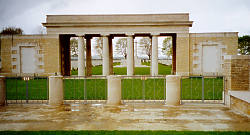On July 23, 1944, the Headquarters of the First Canadian Army became operational under the command of General Crerar. This First Canadian Army would become international in character. In addition to its Canadian divisions (the 2nd and 3rd Infantry and the 4th Armoured divisions), it had a Polish division, British corps and at various times American, Belgian and Dutch troops.
As the Americans swept round from the south enveloping the German troops in a huge pocket, General Crerar's First Canadian Army was ordered to Falaise along the line of the pocket's opening. Lieut.-General G.G. Simonds, in command of the 2nd Canadian Corps, planned the operation to take place at night using armoured personnel carriers to transport the infantry, and tanks to both spearhead and follow the assault. The attack began just before midnight August 7, preceded by heavy air bombardment, directed by red and green flares fired by the artillery. The attack achieved initial success, as the first defensive lines were overrun including the ridge at Verrières where Canadians had died in the July campaign. Then, in the face of stiff German resistance and errors in Allied bombing which inflicted casualties on their own troops, the momentum could not be maintained.
It was vital that Falaise be captured without delay to unite with the American forces moving up from the south. General Simonds ordered a second assault. Similar tactics were employed except that this time the attack took place in daylight with smoke screens replacing the cover darkness had given in the earlier phase. There was again an error in Allied bombing, but this time the assault succeeded. Falaise was taken on August 16.
Like most Second World War cemeteries, Bretteville-sur-Laize Canadian War Cemetery is a concentration of battlefield burials; almost every unit of the 2nd Corps is represented here. There are 2,793 Canadian soldiers buried in the cemetery, 91 of them unknown. With them lie 79 members of the R.C.A.F.
The town which has given its name to the site is near the road between Caen and Falaise, a fitting location for a burial ground that, like the towns, is a memorial itself. The fields of grain which enclose it were once crushed by tanks, armoured carriers and guns that churned through the hot, dusty days of August 1944. Now, on its slight plateau above the farmland, there is peace. The cemetery has a fine entrance. Near the gate, the Stone of Remembrance rests upon granite steps facing the Cross of Sacrifice across the headstones. It is easy to find for it is located beside the road to Falaise, 14 kilometers from Caen.
